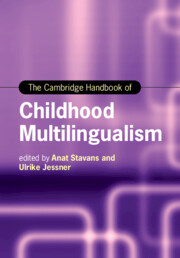Book contents
- The Cambridge Handbook of Childhood Multilingualism
- Cambridge Handbooks in Language and Linguistics
- The Cambridge Handbook of Childhood Multilingualism
- Copyright page
- Contents
- Figures
- Tables
- About the Editors
- Contributors
- Acknowledgments
- Multilingualism Is Not Bilingualism +1: An Introduction
- Part One Becoming and Being a Multilingual Child
- Part Two Cognition and Faculties in Multilinguals
- Part Three Family Language Policy
- Part Four Language(s) and Literacy of Multilingual Children through Schooling
- 15 Being Plurilingual in the Language Classroom
- 16 Literacy Development in the Multilingual Child: From Speaking to Writing
- 17 Attitudes, Motivations, and Enjoyment of Reading in Multiple Languages
- 18 Growing Up with Multilingual Literacies and Implications for Spelling
- 19 Assessing Multilinguals
- 20 Plurilingualism and Young Children’s Perspectival Cognition
- Part Five Socialization in Childhood Multilingualism
- Part Six Multilingual Children’s Landscape
- Subject Index
- Country Index
- Language Index
- References
18 - Growing Up with Multilingual Literacies and Implications for Spelling
from Part Four - Language(s) and Literacy of Multilingual Children through Schooling
Published online by Cambridge University Press: 18 August 2022
- The Cambridge Handbook of Childhood Multilingualism
- Cambridge Handbooks in Language and Linguistics
- The Cambridge Handbook of Childhood Multilingualism
- Copyright page
- Contents
- Figures
- Tables
- About the Editors
- Contributors
- Acknowledgments
- Multilingualism Is Not Bilingualism +1: An Introduction
- Part One Becoming and Being a Multilingual Child
- Part Two Cognition and Faculties in Multilinguals
- Part Three Family Language Policy
- Part Four Language(s) and Literacy of Multilingual Children through Schooling
- 15 Being Plurilingual in the Language Classroom
- 16 Literacy Development in the Multilingual Child: From Speaking to Writing
- 17 Attitudes, Motivations, and Enjoyment of Reading in Multiple Languages
- 18 Growing Up with Multilingual Literacies and Implications for Spelling
- 19 Assessing Multilinguals
- 20 Plurilingualism and Young Children’s Perspectival Cognition
- Part Five Socialization in Childhood Multilingualism
- Part Six Multilingual Children’s Landscape
- Subject Index
- Country Index
- Language Index
- References
Summary
Growing up multilingually and in a multilingual social environment affects the acquisition of literacy. Many multilingual children learn to read and write in the language required by the institutional context. This is often a second, sometimes unfamiliar, language for them and it is the dominant language of the society they live in. However, these children might also learn, or be in contact with, other written languages used in their families and communities. The practices in all written languages vary, and family or community languages and literacies might be typologically close or distant from the language and literacy practices expected at school, which is the main institution for literacy acquisition. Unfolding the resources and needs of multilingual children’s literacy acquisition is at the center of this chapter. The contexts of literacy acquisition in multilingual societies is presented on three different levels: by defining literacy and literacies, by presenting different multilingual and multiliterate contexts, and by zooming in on one aspect of literacy, that is, spelling.
Keywords
- Type
- Chapter
- Information
- The Cambridge Handbook of Childhood Multilingualism , pp. 415 - 440Publisher: Cambridge University PressPrint publication year: 2022

